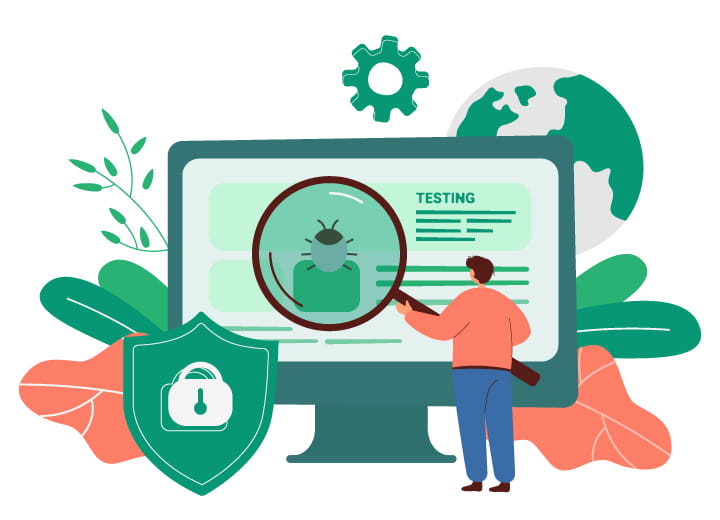Customized software solutions automate manual processes to enhance efficiency, accuracy, and business security. Understanding the cost calculation is essential for all parties involved in software development. So if you are the decision maker for a business interested in a software project, or a software developer assigned to one, this guide will provide a clear idea of the intricacies involved in software development.
Calculating the cost of software is an essential task for any form of project. It helps to set budget expectations, allocate resources, and make informed decisions about technology investments. In this guide, we will walk you through the different factors that go into determining the cost of a software project, including the scope of work, the size and complexity of the project, the technologies and tools being used, and the experience and expertise of the development team. With a better understanding of these factors, you will be able to more accurately estimate the cost of your software development project and make more informed decisions about your technology investments.
Checklist
What is Software Development?
Software development is the process of creating, designing, testing, and maintaining software. It involves a methodology, variety of tasks and responsibilities, such as analyzing user requirements, writing and testing code, and debugging software. Software developers use programming languages, such as Java and C++, to write code that can be turned into functional software.
Software development includes a wide range of projects i.e. from creating simple mobile applications to developing complex software systems according to client requirements. The goal of software development is to maintain quality assurance to create high-quality software that meets the needs of users while solving problems effectively and efficiently.
Why is Software Development Important?
Software development is important because it allows the creation of custom solutions that can automate any process, improve efficiency, and increase productivity. The most crucial phase is to align with the methodology that will be used to progress the software development, since it sets milestones and provides a better perspective to the developers and the client. As a result of the increasing popularity of agile methodology in the industry, professionals are opting for it. It also allows us to adapt, for say a business, to changing market conditions and customer needs by quickly creating and deploying new software. In addition, software development helps anything to stay relevant in today’s digital world by providing a way to innovate while enabling better management.
Ways to Calculate Software Development Cost
These are the numerous crucial factors when it comes to software development. Let’s look at the factors that mainly play a role in the overall budget estimation of a software development project:
- Scope of Software Project
- Technology stack
- Infrastructure model
- UI/UX design
- Development and Management
- Testing and Security
- Update and Maintenance
Guide to Calculate the Cost of Software Development

When planning a software development project, it is essential to consider all the factors that could impact the cost. This includes planning and analyzing the project’s features, requirements, and budget well in advance. Much like doing a cost analysis before purchasing a ready-made product as a client, it is also a good idea to do a cost analysis before starting software development work with an actual development team. It is extremely critical to review every detail of the project earlier because even the minute aspect can affect the final price.
Below listed is a step-by-step guide on calculating the estimated cost of a software development project while analyzing the three key cost factors of any software development project:
Step 1: Understanding the Type of Software Project
Understanding the type of software development project is the first step in developing a cost estimate. For example, a software development project involving developing a web-based software application will require more manual hours for the team involved to develop the project rather than a project involving developing a mobile application.
Software development projects are majorly classified as the following based on type:
- New Software Development Project: New software involving custom development is developed according to client requirements. Developing custom applications according to client requirements and mobile applications falls under this category.
- Software Modification Project: Update and modification of an existing software project according to new features. Bug fixes projects fall under this category of projects.
- Software Integration Project: Custom code to add capability or integrate existing software into other processes. This would include plugins to packages like Office as well as manipulating data flowing between an inventory system like Netsuite with an accounting system like Quickbooks. Concept applications mainly fall under this category instead of new software development as they are seldom built from scratch.
- Web Development Project: Custom web-based software development project developed according to client requirements.
Each type of project listed typically has a different team makeup and requires a different amount of development effort. The given information is used in combination with the size of the project and the project team to determine the final estimate. A sample cost estimation has been listed category-wise in the Sample Project with Cost Estimation segment of this blog.
Step 2: Determining the Size of the Software Project
The next step is to determine the size of the project. Generally, there remains a direct relation between the complexity of a project with its size, thus also with the related factors like time duration and cost estimation of the project. It is possible to analyze these two factors by categorizing the project size into three basic size categories:
- Small Software Development Project: Small projects involve minor changes like bug fixes, tweaking the user interface, etc.
- Medium Software Development Project: Medium projects mostly involve standalone solutions or integration works. Projects under this category include developing mobile application software and similar software development projects. The client communication required for this size of project is more than for small projects. As a result, some associated cost factor arises for maintaining client communication as listed under the hidden cost factors segment of this blog.
- Large Software Development Project: These projects include more complexity and team involvement. Large projects require further technical support like having integration with multiple systems, a database component, address security and logging features, an underlying framework, a module-based design, and consideration for scalability and maintenance. Multi-platform (macOS, Windows, Linux, etc.) software development projects would fall under this category. The external requirements for interaction with the client are of high priority thus resulting in more unforeseen hidden cost factors.
Usually, considering the above-mentioned factors, the sales department of a software development project gives a time estimate to the clients and sets deadlines accordingly for the team.
Step 3: Considering the Development Team Size
Once the project is defined in terms of type and size, the next factor to be determined is the main team size. This is also the main area where one can drive the overall cost down. This factor has further been broken down into multiple factors for better understanding purposes:
- Project Roles: Like any other project, a software development project also requires the involvement of a team on multiple roles designated with specific tasks. However, any software development project requires at least these three roles – Project Manager, Developer, and QA Tester. Depending on the size of the project, multiple people fill in a single role at times while a single person might fill multiple roles as well. Some additional roles required as part of the team to effectively move the project forward includes UI/UX designer, Business Analyst, Software Designing Architect, Database Manager, etc.
- Hiring Models: Hiring models to include a very important topic – developers’ location. The location makes a big difference in the overall software development cost, especially when living costs, business expenses, and taxes associated with a developer are considered. Hiring can easily be done in-house, remotely locally, or remotely offshore, however, it is possible to save up to 50% of the development budget if hiring is done offshore. Some such offshore locations include South East Asia, Central Europe, the Middle East, etc.
- Developers Level: Undoubtedly the more skilled a developer is, the higher the development cost. This is why the right way to form a developer team is to include an effective mix of developers who will move the project at a synced pace.
Hidden Cost Factors
The hidden costs of a project are the unforeseen or indirect costs or factors that are essential for the completion of the project. In most scenarios, hidden costs arise while developing and implementing the software, thus escaping the initial cost estimation budget. This is an extremely important aspect of the overall software development process and thus a few hidden costs have been discussed below as a heads-up:
1. QA and Testing

If simple techniques for software testing are undertaken, the overall cost of development will be reduced; thus, emphasis on software testing is fairly significant. Quality Assurance or QA is the process of testing and verification of a software development project in its workflow. Typically a Quality Assurance Engineer is present as part of the Software Development team who does this job. The production costs take unexpected turns as a lot of unexpected errors occur during a project which is detected during QA testing. It is important to have processes in place as much as possible to prevent such issues from occurring.
2. Loss Time
Many a time a product is developed which results in not being delivered or a delay in delivery. This factor results not only in a loss of time but also an increase in the overall development budget as well. The key to avoiding such unnecessary factors is to simply focus on the soft aspects of the development project concerning communication, expertise, or synced work hours.
3. Expensive Infrastructure Challenges
Software developers not only need good equipment but also infrastructural support like incl proper connectivity, bandwidth, storage space, and power supplies, all of which consist of a big portion of the overall budget. However, it is possible to mitigate these challenges easily by outsourcing your project to an offshore team such as DCastalia or hiring an offshore developer team as analyzed in the guide of this blog. This way, the entire equipment, and infrastructural support costs can be eliminated.
4. Communication costs
Communication costs are the most underrated factor in software work, whereas this is the aspect that drives the entire software development process the most. Due to poor communication, poor expertise, and difference in time zones, a huge portion of employee work hours results in lost time and thus an increase in initial cost estimation as well.
5. Continual maintenance
Any project involves continuous support or maintenance costs. For software development projects, such support may include bug-fixing patches or feature updates. The better way to tackle this issue is by monitoring the maintenance costs all the time and in case of any necessary upgrades, adjusting the project budget accordingly.
Sample Projects with Cost Estimation
-
Concept Applications
|
Type |
New Software Development Project |
| Size |
Small |
|
Time Frame |
4-8 weeks approx |
| Cost Estimation |
$25k-$35k approx. |
- Mobile Applications
|
Type |
New Software Development Project |
| Size |
Medium |
|
Time Frame |
16-20 weeks approx |
| Cost Estimation |
$60k-$70k approx. |
- Bug Fixing
|
Type |
Software Modification Project |
|
Size |
Small |
| Time Frame |
1-2 weeks approx. |
| Cost Estimation |
$2k-$10k approx. |
Conclusion
Calculating the cost of software development is a complex process that involves a variety of factors such as the type of project, the team’s experience, skills, and the tools and technologies used. It is important to thoroughly assess all of these factors and to create a detailed project plan to accurately estimate the cost of development and execute the project on time. By simply following the steps outlined in this guide, it is possible to calculate the cost of a software development project and make informed decisions about your budget and resources.


